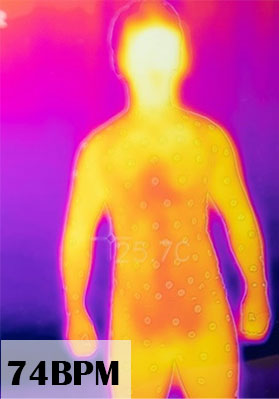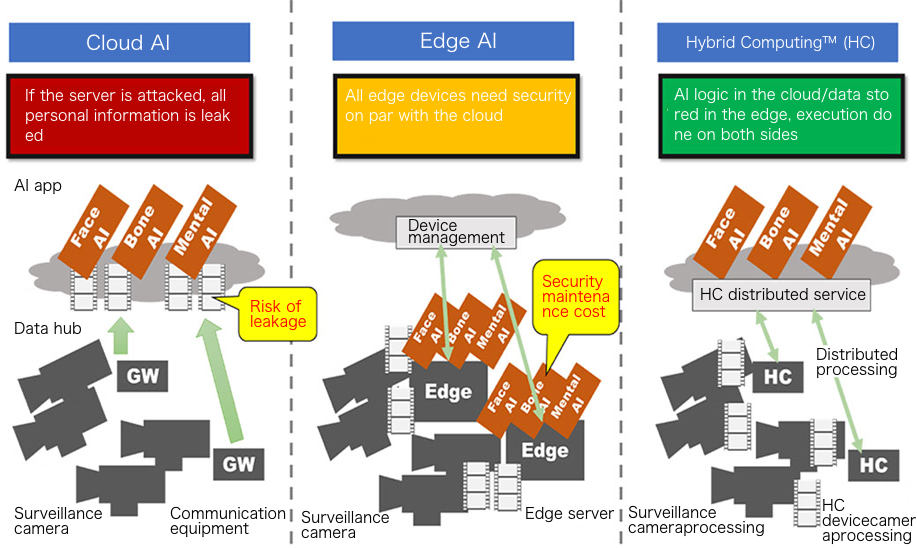AI solutions
An example of Hybrid Computing™ in actionA privacy protection AI that handles jumbo data

As AI technology evolves, surveillance cameras are rapidly gaining popularity. Videos collected by surveillance cameras are large-volume data in single-file units. We call them "jumbo data" to differentiate them from "big data," which refers to massive collections of small POS and GPS data. Jumbo data and big data are analyzed using different techniques.

Protects privacy without transferring data into the public cloud
The popularity of the 'public cloud' offered worldwide by GAFA and other tech giants has raised concerns about risks of information leakage when all private information is collected in the cloud. The evolution of AI technology has made it possible to analyze things that were unimaginable when surveillance cameras were developed, such as heartbeats, eye movement and mental condition, based on the jumbo data they collect. But saving such jumbo data, which are huge masses of personal information, poses a major security risk. Hybrid Computing™ technology was developed to avoid that risks by using AI analysis to control and analyze jumbo data near the surveillance camera without saving them in the cloud. This technology makes it possible for an AI in the cloud to analyze data in the surveillance camera without transferring them to the cloud. That reduces the risk of personal information leakage from the cloud and enhances privacy protection.
Multiple international patents and academic papers have been published concerning Hybrid Computing™ technology. It was awarded first prize at MIT VFJ BPCC18, and has begun to be applied as a platform for distributed AI implementation.

Distributed security fused with the cloud and Edge
 In order to make full use of highly advanced AI like the Smart Store, multiple surveillance cameras must be working together, and the following three methods are primarily employed.
In order to make full use of highly advanced AI like the Smart Store, multiple surveillance cameras must be working together, and the following three methods are primarily employed.
The cloud AI is the most popular type. Because all videos are collected in the cloud and analyzed, all kinds of AI can be employed with the highly advanced security and powerful processing capacity of the cloud. On the other hand, all client information would leak if the cloud were attacked.
Edge AI is a type of AI system steadily gaining popularity. Since the AI is distributed on to the edge side, there is no need to collect all data in the cloud. Because the edge server cannot secure sufficient processing capacity, only simple processing is done, and large-scale analyses will generally be done on the server. On the other hand, numerous AI, all requiring security management, must be distributed in the edge. Although the OS and communications of the edge server are encrypted for security purposes, the security holes of the AI apps themselves must be dealt with in each instance.
Hybrid Computing™ (HC) is a system that leaves videos in the edge and analyzes them via an AI in the cloud. Only disposable distributed processing logic is exchanged between the cloud and edge, enabling dynamic changes to the loads on the cloud and edge. The security of HC in the edge is automatically updated, eliminating the need to manage the security of multiple AI individually. Since videos are not collected in the cloud, even if the cloud were attacked, only the AI app and the small amount of data being processed would be compromised, and not all personal information would be leaked. Through HC technology, cloud AI and Edge AI, which previously needed to be combined manually, can now be combined dynamically, enabling the construction of a new distributed security model.
Combining convenience and privacy allows us to do more with AI
Take analysis of the flow of people in a store as an example of multiple surveillance cameras working together. When a highly advanced AI is used in a smart store or other business, specific individuals can be identified and their actions can be traced in sequence. While there are more and more cases of AI tracking down individuals in countries and regions that promote advanced research, there is also growing alarm about collecting too much privacy information in the cloud, such as the GDPR. The store does not intend to infringe upon personal privacy and only seeks to show appropriate products to its customers, so it is necessary to find common ground that will allow convenience and privacy to coexist. HC technology leaves unanalyzed jumbo data that includes personal information in the surveillance cameras, and distributes AI processing so that the cloud is able to trace only the movement of products. Cloud AI increases convenience due to collecting jumbo data in the cloud, but risks privacy infringement. Edge AI, on the other hand, reduces the risk of privacy infringement since jumbo data is not collected in the cloud, but sacrifices convenience because it is difficult to flexibly adapt if the necessity for individual protection changes over time or a new model of AI is developed. HC technology combines the convenience of Cloud AI's ability to flexibly change the AI model with Edge AI's ability to protect privacy without collecting jumbo data in the cloud, allowing increased utilization of AI in smart stores and other settings.

Toward a growing smart city
Cyber Physical System (CPS) is a fundamental concept for realizing the smart city. It is a model that appropriately coordinates the cloud space, or "cyber," with the real world, or "physical." 5G and MaaS are components for realizing CPS. HC technology was also developed as an element of CPS. In CPS, 5G serves as the communication network and MaaS is responsible for applications. HC technology is responsible for the jumbo data platform that enables AI analyses without transferring videos jumbo data. We believe that Cloud AI will continue to take on big data like POS and GPS data. But unanalyzed raw data like sounds and images, that is, jumbo data, are presently just thrown away because they can't be processed. With the further development of AI models, this discarded jumbo data could be a source of new value. For example, research is being done on measuring the progress of dementia by analyzing ways of walking using AI. Using new AI to analyze old jumbo data that had been thrown away when this AI was implemented would make it possible to measure the progress of dementia in the long term, and therefore to provide appropriate rehabilitation programs to maintain patients' quality of life. Using HC technology, we seek to realize a growing smart city that can create new value from wasted jumbo data as AI evolves.

